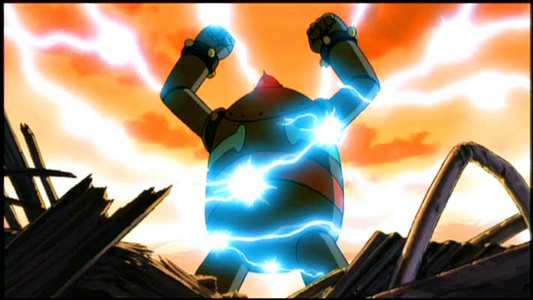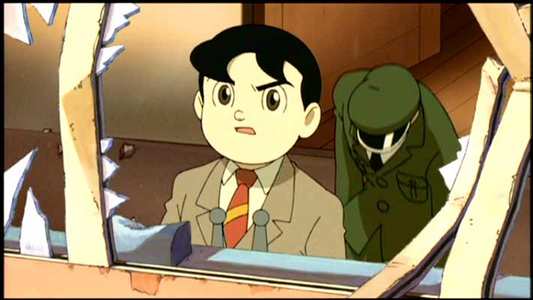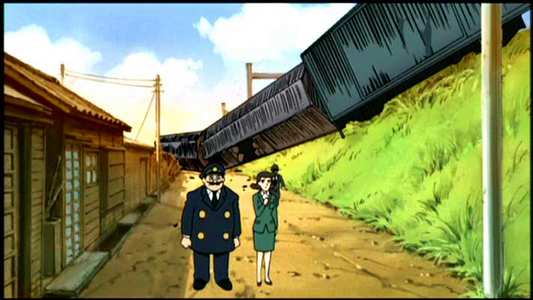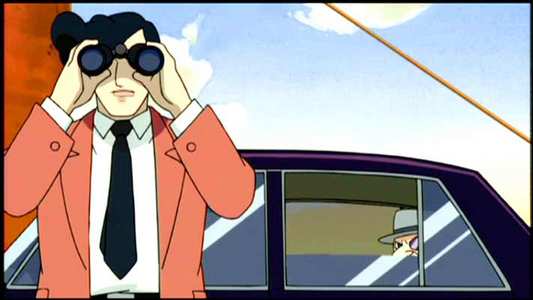Review of Tetsujin 28: Volume 2
Introduction
It`s time for some more retro fun with the second volume of Tetsujin 28 now being released by Manga Entertainment. The post war years are brought to sepia shaded life, complete with giant robots and old-fashioned character designs, although given a 21st Century CGI makeover, in this remake of a classic anime series.
During the dying days of the war, a weapon was created as a devastating last-ditch defence to use against Japan`s enemies. The war ended though and the robot, Tetsujin 28 was never activated. Ten years later, Japan once again looks forward, rebuilding its cities and industry. At the heart of the new wave of engineering is the robotics industry. Shotaro is the orphaned son of the creator of Tetsujin 28, and he has grown up to become a precocious boy detective, mentored by his father`s protégé Shikishima, and the city`s Chief of Police Otsuka. Shikishima is also leading the new innovations in robotics, and it was his signal, ostensibly to activate the latest robot on his production line that accidentally activated Tetsujin 28. The massive war robot arrived in Tokyo amidst devastation, but Shotaro soon worked out how to control it, leading to an unconventional partnership. But the arrival of the robot created enemies for it as well as friends, and in this second volume, avaricious eyes from further afield alight on the potential that Tetsujin 28 represents.
This second volume contains 5 further episodes.
Ep 6. The Remote Control Is Stolen
The American Mafia turn their eyes to Japan and the promise that Tetsujin 28 offers. Controlling this massive war machine would be exceedingly lucrative, but gaining control of a giant robot seems impossible. That`s until Kenji Murasame, still blaming Tetsujin for the death of his brother, decides to throw in his lot with the Mafia and share the snippet of information that Shotaro possesses the robot`s remote control. Meanwhile, a mysterious new robot derails a train.
Ep 7. Tetsujin, Instrument Of Evil, On The Rampage
The Mafia possess Tetsujin, but to Kenji`s horror, they refuse to take it back to America. Instead they unleash a wave of crime upon Japan. Meanwhile Shotaro is recuperating in hospital, blaming himself for the remote control`s theft. Chief Otsuka hatches a plan to regain control of Tetsujin, but to do so he will need the help of the American military, and their own robot. If this plan fails, the Americans stand ready to destroy the massive destructive Japanese weapon.
Ep 8. Recapture Strategy
Otsuka buys time for Shotaro before the US Navy attacks the Mafia`s island hideout. On the island, Shotaro runs into Kenji Murasame, and the two form an uneasy partnership, but Kenji is liable to sacrifice Shotaro in his eagerness to destroy Tetsujin.
Ep 9. The Space Rocket Murders
Japan is about to enter the Space Race courtesy of Professor Shikishima. Professor Dragnet, a collaborator with Shotaro`s father has created a robot named Gilbert to explore the moon, and Shikishima is building the rocket. Shotaro and Tetsujin are to guard the launch site until it is time for lift off, but then disaster strikes.
Ep 10. Kelly The Superhuman
Shotaro`s investigation leads him into danger when another of his father`s former colleagues is murdered, and a strong human sized robot attacks the police and flees the crime scene. Professor Makimura leaves a dying message that may be a key to the mystery.

Video
The 1.78:1 anamorphic transfer on this disc is a significant improvement on the first volume, even if it does still have a few drawbacks. The macro-blocking, digital banding and artefacts that marred the previous disc, especially during darker and mistier scenes are all but absent now, and the image on this disc is clear throughout. Having said that, there is still a hint of aliasing, and complex dynamic animation (such as rain) does suffer from compression artefacts.
The animation is something of a mixed bag, exhibiting a decidedly retro feel. The colour palette is limited, sticking to muted earth colours, which evoke the forties and fifties well. The character designs are very much of the post war period, short and podgy characters, absurd hairstyles, and somewhat limited in detail. However the world they inhabit is elaborately designed, and the animation is melded with modern 3D CG techniques, giving it a fluid feel and scope that would have been impossible 10 years ago, let alone 50.

Audio
You get Manga Entertainment`s usual offering of soundtrack options, DD 2.0, DD 5.1 and DTS in both English and Japanese, with translated English subtitles. I sampled the English dub, and like most modern dubs it is pretty good. I listened to the show in the original Japanese however, and found the track to be just as impressive, with plenty of ambience and substantial effects for the surrounds to work with. It actually sounded livelier than the previous volume. The music for the show follows the retro feel, with theme tunes exhorting Tetsujin and Shotaro to further successful adventures. Unfortunately, with just the one subtitle track, signs and episode titles go by un-translated when watching in English.

Features
If the last volume`s `Wheel Of Fortune` menu was infuriating, this volume takes a turn for the worse with menus which are if anything even slower and more annoying. Admittedly they are attractive, based on pages of a technical journal and a newspaper, with clips of the show playing where the pictures should be. However waiting for the pages to turn, until your desired menu selection comes up is needlessly time-consuming.
The only extras on this disc are trailers, the newer Manga Attacks and latest Robotech trailer, as well as the usual Art Of Anime reel.

Conclusion
This second volume of Tetsujin 28 continues in much the same way as the first, and once again fails to really inspire any passion in me. I think the same complaints that I had last time still apply here, and the updating of a retro animation, while visually impressive has resulted in a rather tired and old-fashioned story. The characterisations are simplistic, their motivations are clear-cut, and the way that the story develops is always quite predictable. I think that is the whole point though, the retro look is carried through to the way the show develops, and for people looking for a slice of yesteryear this show is ideal. It`s as if someone decided to remake Star Trek for the 21st Century, and took the Original Series, kept the characters and stories the same, but gave it a CG lick of paint. What people accepted in the sixties may not be so palatable today.
The Star Trek analogy is apt for another reason. Shotaro is Wesley Crusher. He`s an annoying, goody-goody know-it-all who always saves the day, and this volume instilled in me quite a dislike for the brat. Once again, it`s an update of an old fashioned anime, where such characters are rife. It`s all taken too seriously and played far too straight for my liking, and I would have appreciated a touch of irony and the occasional modern sensibility to liven things up. As it is, Tetsujin 28 plods its way through the stories, trying to weigh in to philosophical debates about weapons and responsibility, but ten episodes in, they still can`t decide whether Tetsujin is a weapon or a tool, or whether the robot has some sort of self. However, worrying about the metaphysical status of a machine that can only carry out the commands issued to it by its operator is a tad ridiculous.
Given the rather constraining retro framework, the stories do come across well enough, although I did quickly tire of the reliance on flashbacks. The first three episodes allow for much of the metaphysical pondering about Tetsujin, as the Mafia decide that he would be a useful tool in committing crime, and steal the remote control from Shotaro. Shotaro spends much of the time feeling guilty on one hand about losing the remote, while on the other hand wondering if he should be terrified of the `monster` that his father created. While the story is interesting, the degree of soul-searching that the characters go through gets tedious quickly. The final two episodes on this disc are a significant improvement, reintroducing a hint of mystery and action, while cutting down on the dull metaphysics. We get taken back to the birth of the Space Age, and Japan`s attempt to play its part by launching a robot to the moon. These two episodes are certainly more action packed and enjoyable, and if anything reminded me of a Tintin story, with the boy detective and his trusty robot on the trail of nefarious characters and trying to stop mysterious forces. And of course, the disc would end on a cliffhanger.
Tetsujin 28 looks very pretty, but the story and characters are quaint and old-fashioned. You would think that would be a primary goal for a retro-styled remake, but it actually results in a show that adds nothing new. There is entertainment to be had from Tetsujin 28, and it does what it sets out to very well. If you are in the mood for a taste of yesteryear then this could be right up your alley. It`s just that it is not as sophisticated as what I have come to expect from anime.
Your Opinions and Comments
Be the first to post a comment!